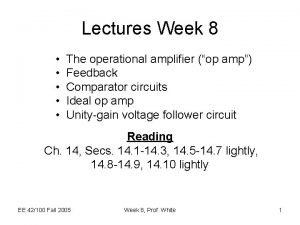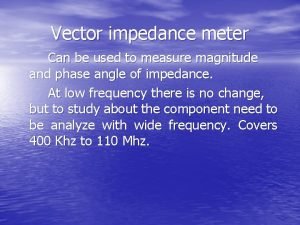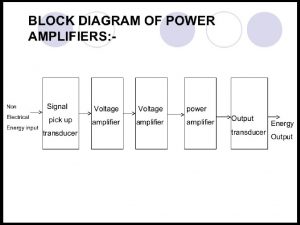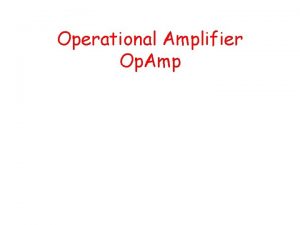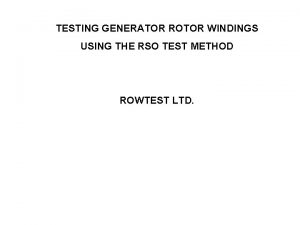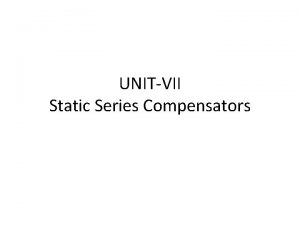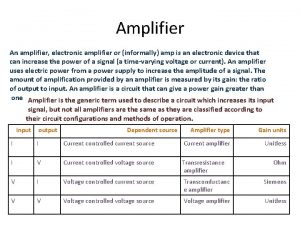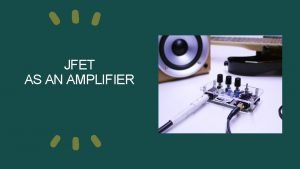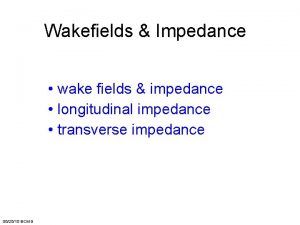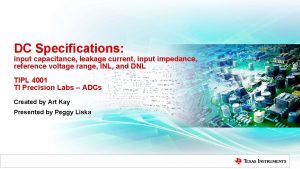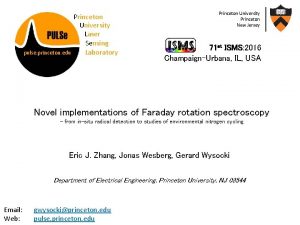Amplifier Input Impedance Test C Lu Princeton University










- Slides: 10

Amplifier Input Impedance Test C. Lu Princeton University (10/14/2014)

Setup for testing input impedance of amplifier Based on Mitch’s suggestion we tested the input impedance of WENTEQ 5008 amplifier. Amplifier R Attenuator(30 d. B) Cable from HP pulser Scope probe(1 MW, 10: 1) Use scope average mode to eliminate the noise, the measured waveforms at #1 and #2 are in next slide.

Input impedance 0, 005 R = 1089 W -1, 50 E-08 -1, 30 E-08 -1, 10 E-08 -9, 00 E-09 0, 000 V 1 = -24. 7 m. V -7, 00 E-09 -5, 00 E-09 V 2 = -1. 18 m. V Ratio = V 2/V 1 = 0. 0479 -0, 005 -0, 010 V 1 -0, 015 V 2 HP Pulse generator V 1 -V 2 -0, 020 Rin = 54. 8 ohm -0, 025 Rin = R* Ratio/(1 -Ratio) = 54. 8 W Scope is in high resolution mode: 12 bits. -0, 030 The tested input impedance of Wenteq 5008 is 54. 8 W. The amplifier’s output Vamp = 292. 34 m. V, Wenteq 5008 amplifier Gain = Vamp/V 2 = 292. 34/1. 18 = 247. 8 = 47. 9 d. B. Manufacturer specs: Gain ~ 47 – 53, our measured value is in this range.

Input impedance (cont’d) We notice that the test signal polarity used is opposite to the real APD signal, which should be positive pulse. We reversed the test pulse polarity, redo the test: Rin = 53. 5 W, the result is same. 0, 35 #2 -bln 0, 30 #1 -bln V 1 max = 0. 286 V V 2 max = 0. 0134 V Rat = V 2/V 1=0. 0469 Rin = R*Rat/(1 -Rat) = 53. 5 W 0, 25 0, 20 0, 15 Scope is in normal resolution mode. 0, 10 0, 05 0, 00 E+00 5, 00 E-09 1, 00 E-08 1, 50 E-08

Input impedance of Mini-circuits ZX 60(2 ns pulse) Test Mini-circuits ZX 60 amplifier: Pulse width = 2 ns, Rin = 79. 6 W. 0, 30 V 2 V 1 0, 25 0, 20 V 1 max = 0. 237 V V 2 max = 0. 0162 V Rat = V 2 max/V 1 max Rin = 1089*Rat/(1 -Rat) =79. 6 W 0, 15 0, 10 0, 05 0, 00 0, 0 E+00 -0, 05 5, 0 E-09 1, 0 E-08 1, 5 E-08 Scope is in normal resolution mode.

Input impedance of Mini-circuits ZX 60(1 ms pulse) Test Mini-circuits ZX 60 amplifier: Pulse width = 1 ms. 0, 4 0, 3 V(V) 0, 2 V 1 0, 0 -200 -0, 1 0 200 400 600 Amplifier -0, 2 -0, 3 t(ns) 0, 4 0, 3 0, 2 V(V) ZX 60 gain curve is not flat from DC to 3 GHz, so its output pulse for 1 us pulse is not so simple. 0, 1 -20 0, 1 V 1 0, 0 -0, 1 0 20 -0, 2 -0, 3 t(ns) 40 60 Amplifier

Remaining mystery of fast leading edge of APD signal If the input impedance of these tested amplifiers is around 50 ~ 70 W, it remains as a mystery: why the leading edge of the APD signal is so fast: ~800 ps? ! For an exponential curve y = 1 - e-t/RC, it takes 2. 2 RC from 10% to 90%, 2. 2 RC = 0. 8 ns, R = 50 W, C = 7. 3 p. F? ! It means the APD output capacitance is only ~ 7. 3 p. F? ! Wenteq 5010 Wenteq 5008 Leading edge 770 ps Leading edge 775 ps

Mystery solved Let us re-exam the signal formation mechanism in APD. The signal obtained on the electrode actually is due to the induced current created signal on the load (amplifier’s input impedance), there is nothing to do with the capacitance of the APD. The capacitance of the APD is in series (not in parallel) with the input impedance of the amplifier, as shown in the plot below: Therefore the leading edge of the APD signal characterizes the APD induced current.

Characteristic of the induced current in APD Electron and hole saturated drift velocity in silicon: ( J. Becker etc. Solid. State Electronics, 56(2011)104) Assume RMD APD P-N junction high E-field region (avalanche and signal formation region) is ~ 60 um, according to above plot, the e/h saturated velocity ~ 107 cm/sec, the time for traveling thru the junction is ~ 60 um/107 cm/sec ~ 0. 6 ns, which is similar to the leading edge of APD signal.

Implication of this conclusion To match 0. 6 ~ 0. 8 ns leading edge of the APD signal, as already mentioned in my previous report, the amplifier’s bandwidth needs to be Bandwidth ~ 0. 35/0. 7 ns = 500 MHz. Higher bandwidth brings no advantage, only increases high frequency noise. The scope high resolution mode gives us better time resolution in data analysis with constant fraction algorithm. The standard 50 W input impedance can avoid the reflection with 50 W cable. The commercial amplifiers we have tested have their input impedance around 50 W.
 Op amp properties
Op amp properties Vector impedance meter
Vector impedance meter Difference between power and voltage amplifier
Difference between power and voltage amplifier Amplifier
Amplifier Gain-bandwidth product of an op-amp
Gain-bandwidth product of an op-amp Princeton university’s gerrymandering project
Princeton university’s gerrymandering project Generator rotor testing
Generator rotor testing Berikut ini adalah salah satu jenis peripheral input
Berikut ini adalah salah satu jenis peripheral input Finely tuned input
Finely tuned input Variable impedance type series compensator
Variable impedance type series compensator Line currents
Line currents
